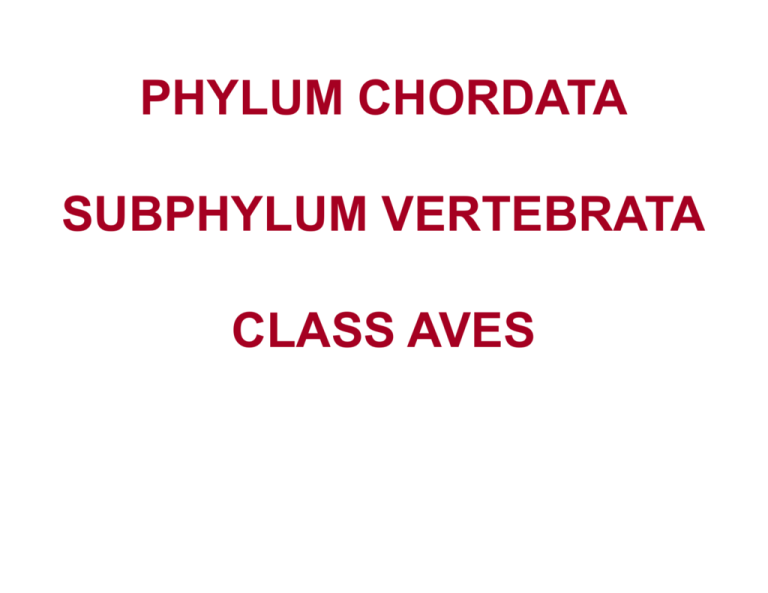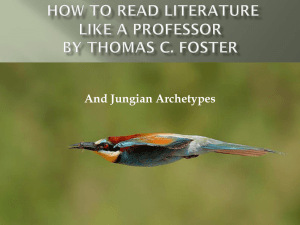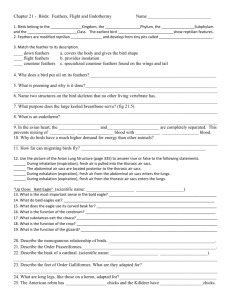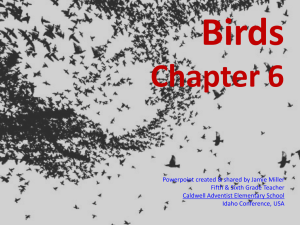PHYLUM CHORDATA SUBPHYLUM VERTEBRATA CLASS AVES
advertisement

PHYLUM CHORDATA SUBPHYLUM VERTEBRATA CLASS AVES Hummingbird Nest California Condor California Condor Vulture Nuthatch Penguin Chick Emu Rhea Ostrich Ostrich OSPREY Wood duck Hummingbirds Peregrine falcon and a flock of starlings Phylum Chordata Subphylum Vertebrata Class Aves Our favorite homeotherm?? Ducks Unlimited Audobon Society York Wildcare (raptor rehab) The National Symbol After fish, the most diverse vertebrate (9000 species) And yet, birds are not diverse anatomically …. WHY?? Flight places severe constraints on form … most species have roughly equal Wings Muscles Feathers Aerodynamic profile What are sources of anatomical variability in birds?? BEAKS FEET Source of Variability: SIZE 1.8 g bee hummingbird 450,000 g elephant bird of Madagascar (extinct) ORIGIN OF BIRDS 19TH Century Zoologists saw similarities between reptiles and birds: • both have single OCCIPITAL CONDYLE • both have only the STAPES in the middle ear • both excrete uric acid • both lay yolky eggs Thomas Huxley (Darwin’s “bulldog”) wrote, “Birds are nothing more than glorified reptiles”. Mammal Bird Occipital Condyle Meat-eaters -Allosaurs -Tyrannosaurs -Velociraptor FACT: New fossils are rapidly accumulating showing that 1) Birds evolved from dinosaurs and 2) The line between dinosaurs and birds is fuzzy 2010 discovery: Haplocheirus sollers - 160 mya (late Jurassic) - bird-like but no feathers - 15 my earlier than Archaeopteryx FEATHERS Why would … why did dinosaurs develop feathers ?? -To have color (camouflage or mate attraction) ?? - Insulation ?? - Gliding ?? The Liaoning Province in NE China is producing amazing Mesozoic fossils the feathered Caudipteryx Caudipteryx Protarcheopteryx 2 years after publication of Origin of Species: Archaeopteryx – strong mix of reptilian and bird characteristics Feathers large Archaeopteryx features reptilian = blue minimal bird = red fusion NO DOUBT Archaeopteryx Archaeopteryx • probably not the first flier • body-wing proportions bird-like • feather patterns bird-like • large furcula • recent finding: rectangular sternum for muscle attachment • maybe roadrunner-like FLEXIBILITY RIGIDITY Modern Birds Generate Thrust Types of Feathers Generate Lift Frigate bird 7 foot wing span 4 oz skeleton !!!!!!!!!!!!!! Skull and wings are light Fallacy: All bird bones are light Sternum and legs may be heavy Feathers are dead > 90% keratin ! Feathers are epidermal (homologous to reptile scales) with hooklets 1 barb may have 1200 barbules ! Preening? Mammalian Skin MOLTING – following breeding season Gradually & orderly Feathers lost in left/right pairs Symmetry permits flight birds are TETRAPODS Wings are homologous to other pectoral appendages Wrist/digits reduced and fused * Sternum ** ** Bracing for rigidity ** Side View Location of Flight Muscles Upstroke Muscle location?? NO ! Why Here? Antagonistic Flight Muscles 25-35% of body wt. in strong fliers TUNA Wild Bird: DARK MUSCLE •Large capillary supply •Many mitochondria •Myoglobin •Sustained aerobic metabolism Thanksgiving Turkey: WHITE MUSCLE Tergum Indirect Flight Muscle Direct Flight Muscle Sternum No Clavicle No Coracoid Small Sternum Large Sternum Clavicle Coracoid SOARING FLIGHT Faster flow Slower Faster-moving air Cambered Air Foils Really Work !! Function?? Flapping Flight: Horrendously Complex … Yet, fledglings do it perfectly the 1st time ! Secondary feathers – lift Primary feathers - thrust Source of Lift Source of Thrust Downstroke More Thrust Upstroke HOVERING FLIGHT Extreme Shoulder Rotation Nature … Hummingbirds: Magic in the Air http://video.pbs.org/video/1380512531/ 2:30 – 6:00 Aspect Ratio = wing length mean width Maneuverable low ratio Speed high ratio Soaring high ratio High lift medium ratio strong camber Peregrine Falcon Q: Does flight impose size limitations on birds?? Upper limit: 15 kg?? buzzards, swans, condors ?? Why?? Argument: as size increases, volume increases faster than surface area 1) Volume = length3 Surface area = length2 2) As bird size increases, volume (and weight) increase fast 3) Surface area and (wing area) increase less fast 4) Wing SA must increase faster than other surfaces 5) But, driving very large wings requires much heavy muscle VIDEO Wild Moves Birds: Flying and Gliding DVD QL 6 Chps 2-5 ~ 17 min The amazing FRIGATE BIRD Nonstop fliers (except for parental care) Fly 24/7 … sleep?? Exceptionally HUGE respiratory system ?? TIDAL VENTILATION in Amphibians, Reptiles and Mammals OUT IN Observations about tidal ventilation * alveoli never fully empty * alveolar air is a mix of fresh and stale * air in alveolus is motionless O2 Partial Pressures Air = ~ 159 mm Hg Alveoli = ~ 100 (location of parabronchi) • No diaphragm • Rigid lungs • Rigid rib cage Gas-exchange Site Chicken – 400 parabronchi/lung Duck - 1800 O2 Partial Pressures Air = ~ 159 mm Hg Parabronchus = ~ 159 1 * SEM of a Chicken Lung Note Numerous Air Capillaries Whooping Crane Trachea (huge anatomical dead space) Oxygen Consumption in a Anna Hummingbird 24 h O2 BEHAVIOR Perching Flying/hovering HOURS mL/hr 10.5 75.4 794 2721,2 639 12.6 140 2.4 Roosting/Torpor 11.1 1heart 2may Daily rate may reach 1200 beats/min!! eat 100% of its body wt./day!! mL O2 HOW FAST TO FLY?? HOW FAST TO FLY?? Which animals are bipedal ?? NO NO What other amazing animals are bipedal ? MATING Copulation looks “normal” but … Penis-less (?!) (Cloaca to Cloaca Sperm Transfer) BIRD REPRODUCTION Single Fertilization region Albumen glands coat egg with “egg-white” Egg Shell (Chicken) 94% CaCO3 1% MgCO3 1% CaPO4 3-4% protein 6,000-17,000 pores/egg Birds are Homeotherms … Eggs are not !! Interspecific Brood Parasitism Lay your eggs in another species’ nest!! Brilliant: transfers the task of parenting to the host Common among birds: 1% of all bird species lay their eggs in another species nest. Examples: Honeyguides, cuckoos, finches, cowbirds. European great spotted cuckoo disposing of eggs from a host nest Blind cuckoo chick ejecting host egg … Later, host chicks are similarly ejected. Cowbird (a brood parasite) Host Chick Parasitic Chick Vocal Mimicry !! Birds may be relatively MONOGAMOUS … Why?? 1) Males fully capable of parental care. 2) Offspring success may depend on male help. EXAMPLE: Female penguin can't do it all -- male sits on eggs/warm chicks while the female is foraging. Male has to stay … or his young will die. BONUS: Long-term monogamy eliminates the need to acquire a new mate each breeding season (e.g., bald eagle) Seasonal Fluctuations in Testes Size in Birds Mate-guarding by male warbler Male is tricked by model eggs Alternative to Monogamy: POLYGYNY Example: LEKS in birds Leks are aggregations of males for the sole purpose of displaying to females Sage Grouse Black Grouse Black Grouse: Male Mating Success Most Successful Males Over 5 Years # copulations Bird Reproduction: SEXUAL SELECTION! Long-tailed widow bird …. MALE!! BOWER Adornments





